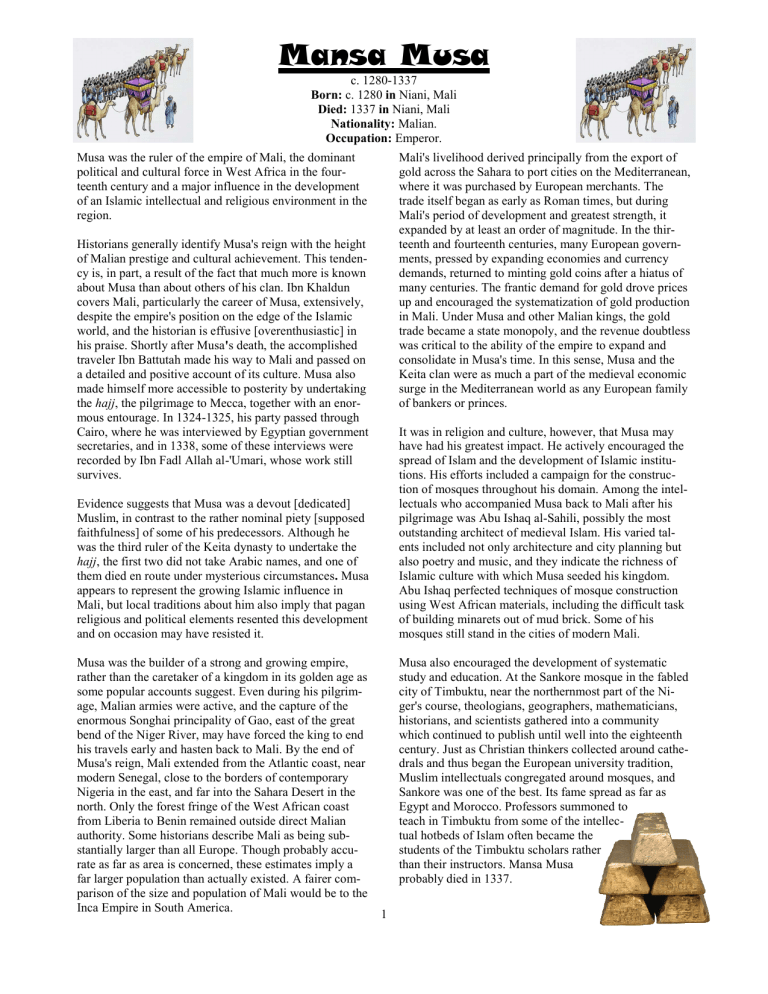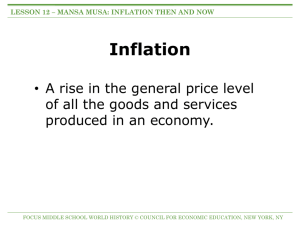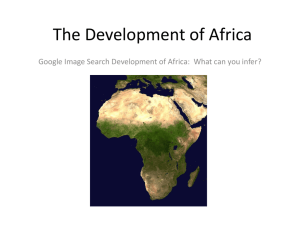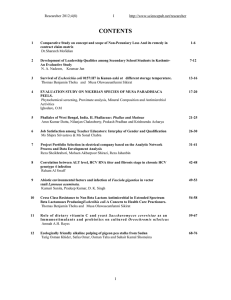
Mansa Musa c. 1280-1337 Born: c. 1280 in Niani, Mali Died: 1337 in Niani, Mali Nationality: Malian. Occupation: Emperor. Musa was the ruler of the empire of Mali, the dominant political and cultural force in West Africa in the fourteenth century and a major influence in the development of an Islamic intellectual and religious environment in the region. Mali's livelihood derived principally from the export of gold across the Sahara to port cities on the Mediterranean, where it was purchased by European merchants. The trade itself began as early as Roman times, but during Mali's period of development and greatest strength, it expanded by at least an order of magnitude. In the thirteenth and fourteenth centuries, many European governments, pressed by expanding economies and currency demands, returned to minting gold coins after a hiatus of many centuries. The frantic demand for gold drove prices up and encouraged the systematization of gold production in Mali. Under Musa and other Malian kings, the gold trade became a state monopoly, and the revenue doubtless was critical to the ability of the empire to expand and consolidate in Musa's time. In this sense, Musa and the Keita clan were as much a part of the medieval economic surge in the Mediterranean world as any European family of bankers or princes. Historians generally identify Musa's reign with the height of Malian prestige and cultural achievement. This tendency is, in part, a result of the fact that much more is known about Musa than about others of his clan. Ibn Khaldun covers Mali, particularly the career of Musa, extensively, despite the empire's position on the edge of the Islamic world, and the historian is effusive [overenthusiastic] in his praise. Shortly after Musa's death, the accomplished traveler Ibn Battutah made his way to Mali and passed on a detailed and positive account of its culture. Musa also made himself more accessible to posterity by undertaking the hajj, the pilgrimage to Mecca, together with an enormous entourage. In 1324-1325, his party passed through Cairo, where he was interviewed by Egyptian government secretaries, and in 1338, some of these interviews were recorded by Ibn Fadl Allah al-'Umari, whose work still survives. It was in religion and culture, however, that Musa may have had his greatest impact. He actively encouraged the spread of Islam and the development of Islamic institutions. His efforts included a campaign for the construction of mosques throughout his domain. Among the intellectuals who accompanied Musa back to Mali after his pilgrimage was Abu Ishaq al-Sahili, possibly the most outstanding architect of medieval Islam. His varied talents included not only architecture and city planning but also poetry and music, and they indicate the richness of Islamic culture with which Musa seeded his kingdom. Abu Ishaq perfected techniques of mosque construction using West African materials, including the difficult task of building minarets out of mud brick. Some of his mosques still stand in the cities of modern Mali. Evidence suggests that Musa was a devout [dedicated] Muslim, in contrast to the rather nominal piety [supposed faithfulness] of some of his predecessors. Although he was the third ruler of the Keita dynasty to undertake the hajj, the first two did not take Arabic names, and one of them died en route under mysterious circumstances. Musa appears to represent the growing Islamic influence in Mali, but local traditions about him also imply that pagan religious and political elements resented this development and on occasion may have resisted it. Musa was the builder of a strong and growing empire, rather than the caretaker of a kingdom in its golden age as some popular accounts suggest. Even during his pilgrimage, Malian armies were active, and the capture of the enormous Songhai principality of Gao, east of the great bend of the Niger River, may have forced the king to end his travels early and hasten back to Mali. By the end of Musa's reign, Mali extended from the Atlantic coast, near modern Senegal, close to the borders of contemporary Nigeria in the east, and far into the Sahara Desert in the north. Only the forest fringe of the West African coast from Liberia to Benin remained outside direct Malian authority. Some historians describe Mali as being substantially larger than all Europe. Though probably accurate as far as area is concerned, these estimates imply a far larger population than actually existed. A fairer comparison of the size and population of Mali would be to the Inca Empire in South America. Musa also encouraged the development of systematic study and education. At the Sankore mosque in the fabled city of Timbuktu, near the northernmost part of the Niger's course, theologians, geographers, mathematicians, historians, and scientists gathered into a community which continued to publish until well into the eighteenth century. Just as Christian thinkers collected around cathedrals and thus began the European university tradition, Muslim intellectuals congregated around mosques, and Sankore was one of the best. Its fame spread as far as Egypt and Morocco. Professors summoned to teach in Timbuktu from some of the intellectual hotbeds of Islam often became the students of the Timbuktu scholars rather than their instructors. Mansa Musa probably died in 1337. 1 The greatest irony of Musa's career is something he himself could not have known. When his pilgrimage entourage arrived in Cairo in 1324, it brought so much gold that it dumbfounded local observers. In obedience to Muslim piety, the pilgrims distributed incredible amounts of wealth throughout Egypt, so much that some medieval historians believe that the gold standard in the eastern Mediterranean nearly collapsed. Inevitably, news of this phenomenon traveled along the commercial intelligence network in the Mediterranean, until it reached the famous guild of Jewish cartographers in the Balearic Islands. By 1375, Musa's likeness was appearing on European maps of West Africa, where previously there had been only fabulous beasts to conceal Europe's ignorance of the region. On those maps, Musa was shown seated on a throne of gold. It was the beginning of the end. Almost at the same time as the pagan Songhai began to run amok, Portuguese mariners began probing their way down the African coast, electrified by tales of unbelievable wealth: Mali was doomed. Source Citation: Davis, Ronald W. "Mansa Musa (c. 1280-1337)." DISCovering World History. Online ed. Detroit: Gale, 2003. Discovering Collection. Gale. Arlington High School. Directions: Answer the following questions based on the reading. 1. The reading references the fourteenth century. What years does that include? 1301/1400 2. What two Islamic travelers/historians wrote about life in Mali? Ibn Khaldun and IBN Battutah 3. 4. What is the Hajj? The pilgrimage to Mecca. Give three reasons why the Hajj of Mansa Musa was so much more significant than that of his two predeecessors. He was a very devoted Muslim in contrast to the rather nominal piety first two did not take Arabic names, and one of them died en route under mysterious circumstances. 5. How large was the Malian Empire towards the end of Mansa Musa’s reign? It extended from the Atlantic coast u the coast near Senegal. 6. What resopurce did Mali export to the Mediterranean port cities? What did European governments start doing after a Gold ”hiatus of many centuries”? 7. They encouraged the systemisation of gold production in Mali. How did Musa help expand Islam in Mali? What academic talents did Abu Ishaq al-Sahili posses? Participated in a campaign to build Mosques/ Fantastic Arquitect. 8. What academic pursuits went on at the Sankore Mosque in Timbuktu? Grammar, Math, Geography, History, Physics, Astronomy, Chemistry and more. 9. What unforeseen problem did Musa’s pilgrimage entourage create in Cairo in 1324AD? The gold standared nearly collapsed. 10. By 1375 how had European maps of West Africa changed? Musa mas demonstrated seated in the map in a gold throne. 11. Which European country began sending mariners down the West African coast in search of wealth? Portugal 2 The Huffington Post | Posted: 10/17/2012 12:22 pm Updated: 10/17/2012 4:02 pm You've probably never heard of him, but Mansa Musa is the richest person ever. The 14th century emperor from West Africa was worth a staggering $400 billion, after adjusting for inflation, as calculated by Celebrity Net Worth. To put that number into perspective - if that's even possible -- Net Worth's calculations mean Musa's fortune far outstrips that of the current world's richest man Carlos Slim Helu and family. According to Forbes, the Mexican telecom giant's net worth is $69 billion. Slim edges out the world's second wealthiest man, Bill Gates, who is worth $61 billion, according to Forbes. Some of the oldest fortunes in question date back 1,000 years. No. 7 on the list, for example, is William the Conqueror. The illegitimate son of the Duke of Normandy, William lived between 1028-1087 and gained infamy for invading and seizing England in 1066. According to the Encyclopedia Brittanica, when Musa died sometime in the 1330s, he left behind an empire filled with palaces and mosques, some of which still stand today. But the emperor really turned historic heads for the overthe-top extravagances of his 1324 pilgrimage to 3 Mecca. The trip, which he embarked up on during the 17th year of the monarch's glittering reign, was hosted by the leaders of both Mecca and Cairo and apparently was so brilliant, it "almost put Africa’s sun to shame." Musa's wealth was a result of his country's vast natural resources. The West African nation was responsible for more than half of the world's salt and gold supply, according to Net Worth. Of course, the entry also notes that the fortune was also fleeting. Just two generations later, his net worth was gone -- wasted away by invaders and infighting. As The Independent points out, while the numbers bandied about by this newest list are shocking, many aspects of the run-down aren't surprising: there are no women included, for example, and only three of the richest men are still alive today. Americans dominate the list, however, taking 14 of the 26 spots, including slots two and three. The "poorest" man on the list is Warren Buffet, who had a peak net worth of $64 billion. Buffet, a noted philanthropist, has since given billions of his fortune away, and Forbes now lists his net worth at closer to $44 billion. Directions: Answer the following questions based on the reading. 1. What impressive title has just been bestowed upon Mansa Musa by Celebrity Net Worth? Text 2. How much was Mansa Musa worth after adjusting for inflation? The 14th century emperor from West Africa was worth a staggering $400 billion, after adjusting for inflation, as calculated by Celebrity Net Worth. 3. How much is Bill Gates worth? 124.9 billion USD 4. Why was Mansa Musa so wealthy? Mansa Musa inherited a kingdom that was already wealthy, but his work in expanding trade made Mali the wealthiest kingdom in Africa. His riches came from mining significant salt and gold deposits in the Mali kingdom. Elephant ivory was another major source of wealth. 5. How many Americans are on the list? How many men on the list are still alive? only three of the richest men are still alive today. Americans dominate the list, howev- er, taking 14 of the 26 spots, including slots two and three. 6. Who is the “poorest” man on the list? The "poorest" man on the list is Warren Buffet, who had a peak net worth of $64 billion. Buffet, a noted philanthropist, has since given billions of his fortune away, and Forbes now lists his net worth at closer to $44 billion. 7. Based on the map above, why do you think that the location of Timbuktu helped it become the center of trade and learning in West Africa? Since many roads where connected to it it became a huge meeting point for trade 4





